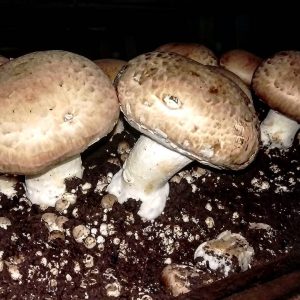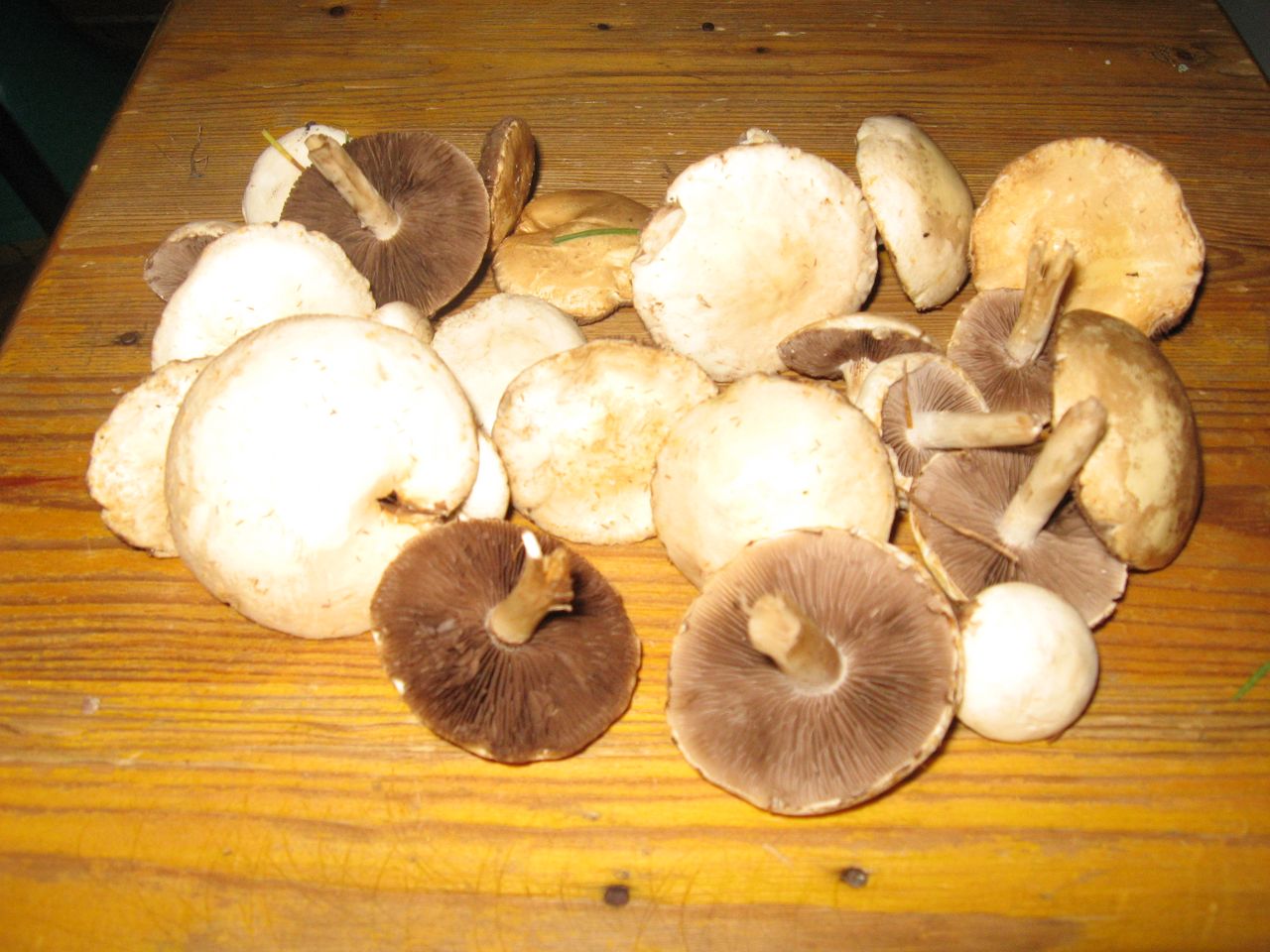Common champignon (Agaricus campestris)
- Other names for the mushroom:
- Champignon real
- Meadow champignon
- Pecheritsa
Synonyms:
Description:
A common champignon cap with a diameter of 8-10 (15) cm, at first spherical, semi-spherical, with a wrapped edge and a private veil covering the plates, then convex-outstretched, prostrate, dry, silky, sometimes fine-scaly at maturity, with brownish scales in the middle, with remnants of a bedspread around the edge, white, later slightly brownish, slightly pinkish in wounded areas (or does not change color).
Plates: frequent, thin, wide, free, at first white, then noticeably pink, later darken to brown-red and dark brown with a purple tint.
The spore powder is dark brown, almost black.
Common champignon has a leg 3-10 cm long and 1-2 cm in diameter, cylindrical, even, sometimes narrowed to the base or thickened, solid, fibrous, smooth, light, one-color with a cap, sometimes brownish, rusty at the base. The ring is thin, wide, sometimes located lower than usual, towards the middle of the leg, often disappearing with age, white.
The pulp is dense, fleshy, with a pleasant mushroom smell, white, slightly pink at the cut, then reddening.
Spreading:
Common champignon grows from the very end of May to the end of September in open spaces with rich humus soils, especially after rains, in meadows, pastures, in gardens, vegetable gardens, parks, near farms, on cultivated land, near housing, on the streets, in the grass, less often at forest edges, in groups, rings, often, annually. Widely spread.
Similarity:
If the common champignon grows near the forest, then it (especially young specimens) can be easily confused with both pale toadstool and white amanita, although their plates are only white, not pink, and there is a tuber at the base of the leg. Still similar to the common champignon, the ginger champignon is also poisonous.
Video about common champignon mushroom:
Grade:
Champignon ordinary - a tasty, healthy, edible mushroom (2 categories), used in a variety of ways, fresh (boiling for about 10 minutes) in the first and second courses, salted, pickled. In terms of the content of proteins assimilated by the human body, it is comparable to the porcini mushroom.
Note: A valuable mushroom of excellent taste, suitable for all types of culinary processing.
Edibility of August mushrooms
These are edible mushrooms of the 3rd category. In terms of nutritional value, champignons are not inferior to porcini mushrooms, and they contain almost the same amount of proteins as in meat. They also taste and smell like dried porcini mushrooms. When collecting, it is recommended to cut them off carefully with a knife so as not to damage the mycelium itself.

The medicinal properties of champignons august
These mushrooms have medicinal properties, since they contain vitamins A, C, PP, phosphorus and potassium. The substances that make up the mushrooms kill the causative agents of typhoid, paratyphoid and staphylococcus.
Other champignons
Champignon Esseta is an edible mushroom with good taste. It grows in conifers, giving preference to spruce forests; in deciduous forests, they are more rare. These mushrooms grow on the forest floor. They bear fruit from July to October. The caps of young Asset mushrooms are spherical, but flatten over time. The color of the mushroom is white. The plates are also white, but with aging they turn brown. The leg is cylindrical, thin, with a broken ring at the bottom.

Curve champignon is also an edible mushroom. The diameter of its cap is 7-10 cm. At first, its shape looks like a blunt bell, after that it resembles a truncated cone, and even later becomes prostrate. The hat is silky, cream or white, with age a shade of ocher appears. If damaged, the cap turns yellow.The plates are first white, then turn red-brown, and at the last stage black-brown. The cylindrical leg reaches 8 centimeters in height and 2 centimeters in diameter. It has a wide, thin, single-layer ring on the stem.
Crooked champignons bear fruit from summer to autumn. They settle in the forest floor. They often grow in groups, but there are also single specimens. The taste of the curve champignon is not inferior to the field champignon. They can be marinated, boiled, salted and made into second courses. Outwardly, the curve of the champignon is similar to the pale toadstool, but it can be distinguished by the strong smell of anise and the formation of yellow spots when pressed.

Basket with August mushrooms.
Field champignon (Agaricus arvensis)
Other names:
Fruit body: Cap with a diameter of 5 to 15 cm, white, silky-shiny, for a long time hemispherical, closed, then prostrate, drooping in old age. The plates are curved, white-grayish in youth, then pink and, finally, chocolate-brown, free. Spore powder, purplish brown. The leg is thick, strong, white, with a two-layer hanging ring, its lower part is broken in a ray-like manner. It is especially easy to distinguish this mushroom at a time when the coverlet has not yet moved away from the edge of the cap. The pulp is white, yellowing when cut, with an anise smell.
Season and place:
In summer and autumn, field champignon grows on lawns and glades, in gardens, near hedges. In the forest, there are related mushrooms with the smell of anise and yellowing pulp.
It is widely distributed and grows abundantly on soil, mainly in open spaces overgrown with grass - in meadows, forest glades, along roadsides, in clearings, in gardens and parks, less often in pastures. It is found both on the plain and in the mountains. Fruiting bodies appear singly, in groups or in large groups; often form arcs and rings. Often grows next to nettles. It is rare near trees; the exception is spruce. Distributed throughout Russia. Common in the northern temperate zone.
Season: from late May to mid-October-November.
Similarity:
A significant part of the poisoning occurs as a result of the fact that the field mushroom is confused with the white fly agaric.
You should be especially careful with young specimens whose records have not yet turned pink and brown. It looks like a sheep and poisonous red mushroom, as it is found in the same places
Poisonous Yellow-skinned Champignon (Agaricus xanthodermus) - a smaller species of champignon, is often found, especially in the plantings of white acacia, from July to October. Differs in an unpleasant ("pharmacy") smell of carbolic acid. When broken, especially along the edge of the cap and at the base of the leg, its flesh quickly turns yellow.
It has similarities with many other mushroom species (Agaricus silvicola, Agaricus campestris, Agaricus osecanus, etc.), differing mainly in larger sizes. Most similar to it is the curve champignon (Agaricus abruptibulbus), which, however, grows in spruce forests, and not in open and light places.
Rating: Excellent edible mushroom. Many mushroom connoisseurs prefer it to all other mushrooms.
Note: Known as Horse Mushroom in English; perhaps due to the fact that this mushroom often grows near stables, on manured soil.
Cooking recipes
You can cook field mushrooms without much effort: they are pickled, fried, fermented, salted, roasted, used in fillings, etc.
Primary processing
After collecting, the mushrooms should be rinsed under running water, cleaned of debris and removed from the top of the cap, which can be easily removed.
Cooking
These fruits are not always boiled, only for making salads, soups or pickling. In other cases, you can use raw mushrooms. Cooking is carried out for no longer than 10 minutes in slightly salted water, then the mushrooms are removed and the liquid is allowed to drain.
Pickling
For the long-term preservation of mushrooms, a rather old method is used - fermentation.It is more harmless to the body than pickling, but the taste of champignons also becomes specific. For cooking you will need to take:
- boiled mushrooms - 1 kg;
- sugar - 30 g;
- salt - 80 g.
How to make field mushrooms for the winter:
- Sprinkle champignons with sugar and salt, mix.
- Put the mass in a saucepan, press down on top with oppression.
- If, after a day, little brine has formed, then you can add water so that the mushrooms are completely covered.
- Remove the container in a warm place, but not warmer than 20 degrees.
You can eat such fruits after a week, and should be stored in closed jars in the refrigerator or basement. They will become most delicious after a month.
Important! All containers and cargo are best sterilized before use.
Pickling
There is a quick way to get delicious pickled field mushrooms, for this you need to cook:
- mushrooms - 1 kg;
- vinegar - 5 tbsp. l .;
- salt - 2 tsp;
- sugar - 2 tsp;
- black peppercorns - 20 pcs.;
- garlic - 7 cloves;
- vegetable oil - 2 tbsp. l .;
- laurel leaves - 2 pcs.
Cooking process:
- Put all the ingredients in a saucepan and put on fire, adding a glass of water. You can crush the garlic slightly.
- Bring to a boil over low heat.
- Remove after 7 minutes.
The mushrooms are ready, it remains to cool them, put them in a jar and pour in the marinade. They should be stored in the refrigerator, but, as a rule, they will not stay there longer than a day.
Freezing
To freeze the mushrooms, it is enough to carry out the initial processing and decompose in portioned bags. If desired, you can boil for no more than 10 minutes and also freeze in portions.
Frying
It is enough to peel and wash the field champignon, remove the film from the cap and cut into convenient slices. They are fried with the addition of vegetable oil. These mushrooms are delicious even as an independent dish, without adding other ingredients, if desired, you can add onions.
Salting
For cooking you need to take:
- mushrooms - 1 kg;
- dill - 100 g;
- garlic - 10 cloves;
- salt - 5 tbsp. l .;
- sugar - 1 tsp
Cooking process:
- Pour boiled mushrooms with water so that it covers them by 1 cm.
- Add spices. Cut the garlic into wedges. Tear the dill with twigs.
- Cover with a plate and place the load. After a day, put in the refrigerator for a week.
- Transfer everything to a jar and store in the same brine.
Mushrooms can be served or rinsed before serving to get rid of excess salt.
Drying
It is easy to dry the mushrooms, it is enough to peel and cut them into slices. Mushrooms should not be washed before drying. You can dry it by stringing it on a thread and covering it with gauze from insects. The fruits are hung out in a sunny, well-ventilated place. It takes 2-3 days for the mushrooms to reach the desired state.
Canning for the winter in banks
You will need:
- field champignon - 2 kg;
- water - 0.5 l;
- salt 1 tbsp. l .;
- sugar - 1.5 tbsp. l .;
- citric acid - on the tip of a knife;
- allspice - 7 pcs.;
- white pepper - 7 pcs.;
- cloves - 8 pcs.;
- a pinch of rosemary and thyme.
Cooking process:
- Boil the mushrooms with the addition of salt and citric acid.
- Strain, drain the liquid and put in prepared jars, pressing a little with your hands.
- In the meantime, prepare the marinade with the listed ingredients. Cook it for 10 minutes on low heat.
- Then immediately poured into jars with fruits in a thin stream.
The jars are closed with tight lids, covered with a blanket. After complete cooling, they are removed to the basement or closet.
Evaluation of taste, medicinal properties, benefits and possible harm
The calorie content of fresh peppers is 27 kcal per 100 grams of product. Fresh mushrooms contain a whole list of vitamins B, E, PP and others. In addition, they also contain useful trace elements: calcium, potassium, manganese, zinc, copper, iron, phosphorus, about 20 essential amino acids. The high-quality protein found in mushrooms is an excellent alternative to meat protein, which the body uses to build cells.
Other useful properties of champignons:
- normalization of the activity of the cardiovascular system;
- lowering the level of "bad" blood cholesterol;
- removes salts of heavy metals;
- mushrooms contain antioxidant substances that fight free radicals.
- mushroom infusion is used to treat wounds;
- in the treatment of diabetes mellitus to lower blood sugar levels;
- folk healers used oven extract to fight typhoid fever.
Doctors warn that it is forbidden to eat any mushrooms for children under 12 years old, pregnant and lactating women, people with exacerbations of chronic diseases of the gastrointestinal tract. Do not forget that mushrooms contain chitin (especially a lot of it in the legs), which is very difficult to digest. Mushrooms are a sponge, they quickly absorb salts of heavy metals, pesticides and nitrates, harmful substances. You should not pick mushrooms near major roads, factories and factories. This is not necessary, because today in stores there is a huge selection of safe bakers grown in an industrial environment.
Taste qualities of champignons Esset
They are edible mushrooms with a good taste. They go well with vegetables, meats and cheeses. Asset mushrooms can be fried, boiled, stewed, baked over the fire and in the oven.
Similar mushrooms of this genus
Field champignon is similar in appearance to Asset champignon, only their places of growth differ - field mushrooms prefer to grow in grassy areas.
Field champignon, it is ordinary - an edible mushroom. The diameter of its silky white cap reaches 5-15 centimeters. For a long time, the cap remains hemispherical, and then becomes prostrate. In older specimens, the caps droop. The color of these mushrooms becomes chocolate brown by old age. The leg is strong, thick, with a hanging two-layer ring on it. The pulp is white with the smell of anise; it turns yellow when cut.
Field mushrooms bear fruit in summer and autumn. Growing places are lawns, glades and gardens. Most often, these mushrooms are found in open areas overgrown with grass. They can settle in highlands and plains.

Often, field mushrooms can be found next to nettles, and they are rarely found under trees. This is a great edible mushroom that many mushroom pickers prefer to other types of mushrooms.
Curve champignon also has a general resemblance to Esset champignon. This mushroom is also edible. The dimensions of his cap are 7-10 centimeters. Its shape at first looks like a dull bell, and over time it becomes prostrate. The color of the cap is cream, and turns yellow in places of damage. The leg is cylindrical, flat, about 8 centimeters long.
Curved mushrooms grow in coniferous forests. They bear fruit from June to October. They settle on the forest floor. Most often they grow in groups, but there are also single specimens. These are delicious edible mushrooms, similar in taste to field mushrooms.

Description of champignon Esset
The fruiting body of the Asset champignon consists of a cap and a well-defined stem. In young champignons, the caps are shaped like balls, later they become convex, and even over time - flat.
The cap and hymenophore are white. Over time, the whitish plates turn gray-pink, and in older specimens they are brown. The leg is cylindrical, thin, the lower part may be slightly widened. There is a torn ring at the bottom of the leg. The color of the leg is white with a pink tint.

Places of distribution of champignons Esset
These mushrooms are common in coniferous forests, most often in spruce forests. They are also sometimes found in deciduous forests, but much less often. The Asset champignons settle on the forest floor. They bear fruit from July to October.
The benefits of champignons Esset
Asset champignons contain a large amount of useful substances: amino acids, vitamins B and D, nicotinic acid, biotin, pantothenic acid.Champignons are rich in protein, which is essential for muscles.
Champignons Esset have a mild diuretic effect, reduce blood sugar levels, prevent the development of atherosclerosis, protect against anemia and the appearance of neoplasms.

How to distinguish field mushrooms from false doubles?
Champignon has a fairly popular and common appearance among other mushrooms.
It should be collected very carefully, especially for not very experienced mushroom pickers.
| Name | Hat and leg | Smell and taste | Growing places | Danger |
| Field champignon
|
White, slightly yellow when broken, hymenophore brown | Smells like anise | Field, open space | Edible |
| Death cap
|
The plates are white, the leg is swollen below, there is a Volvo, the color does not change when broken | The smell of anise is absent, there is no pronounced taste and aroma | Deciduous forests, mixed, fertile soils | Poisonous |
|
Yellow-skinned champignon
|
Smaller, turns yellow very quickly when broken | Has the smell of carbolic acid, for many it is associated with the smell of a pharmacy | Prefers white acacia | Poisonous |
Curve champignon |
The hat is white or creamy; when pressed, bright lemon spots appear | Has an almond or aniseed aroma | Ephedra, especially pines | Edible |
Common champignon |
White mushroom with reddening flesh at the break, the surface is dry, silky | Has a pleasant mushroom aroma | Grows in grass, on well-fertilized soil | Edible |
Cossack champignon |
Smaller fruit, white or cream in color, later turns gray, turns yellow when pressed | Strong smell of anise | Coniferous and deciduous forests | Edible |
| White fly agaric
|
The mushroom is all white, the hymenophore is pink, the ring is hanging down, there is a vulva | Unpleasant taste and smell | Coniferous and mixed forests | Poisonous |
Field champignon and poisonous pale toadstool
In order not to confuse the field mushroom with the pale toadstool, you should pay attention to the following differences:
- the hymenophore in an edible mushroom is darker than the cap, in older ones it becomes brown, and in a poisonous species it is always white;
- the lower part of the champignon leg is even, the toadstool is swollen, tuberous, there is a volva;
- The edible fruit has two rings on the leg, while the poisonous relative has only one, and it is single-layered.
You should also pay attention to the smell emanating from the mushroom: the champignon smells pleasantly of anise, and the pale toadstool has practically no smell
Important! If the mushroom found raises even the slightest doubt, then you should not take it!
Important! If the mushroom found raises even the slightest doubt, then you should not take it!
Champignon double-peeled
| Group: | Lamellar |
|---|---|
| Plates: | violet brown |
| Colour: | Cream, white |
| Info: | The pulp turns red when cut |
| Department: | Basidiomycota (Basidiomycetes) |
|---|---|
| Subdivision: | Agaricomycotina (Agaricomycetes) |
| Class: | Agaricomycetes (Agaricomycetes) |
| Subclass: | Agaricomycetidae |
| Order: | Agaricales (Agaric or Lamellar) |
| Family: | Agaricaceae (Champignon) |
| Genus: | Agaricus (Champignon) |
| View: | Agaricus bisporus (Champignon double) |
Champignon double is considered a valuable edible mushroom, it is used fresh, for frying, cooking, stewing, canning, making salads, pickling.
Dried mushrooms and powder from them are used for making pies, soups, etc. It is assigned to the 2nd category of nutritional value.
Description
The double-peeled champignon is differentiated by colors:
The latter is also called "royal" and is not found in the wild, only cultivated.
The caps of the double-pore champignons are spherical, with edges strongly curled downwards. The surface is smooth and dry. Scaly growths (remnants of bursting velum) can be observed on it.
Also, fragments of the private bedspread remain under the hat. Typically, the caps of double-pore champignons are small (reaching a maximum of 8 cm in diameter).
Leg
The stem of the double mushroom reaches a maximum height of 10 cm. It can grow quite thick - up to 4 cm in diameter.Mature mushrooms have a cavity in the stem. On the surface of the leg, closer to the cap, there is a ring-shaped formation, which is the remains of velum.
The mushroom hymenophore consists of a lamellar layer. In young specimens, the plates are pinkish, and in mature ones, they are purple-brown.
Pulp
Champignons have a dense, white flesh, which, when cut, changes color to reddish. The smell of the pulp is normally pleasant mushroom. If the cultivation technology is violated, the champignon begins to emit an ammonia smell.
Spreading
In nature, double-pore champignon grows on manure and cultivated soils (into which manure is also applied for fertilization), in areas free of vegetation. This type of champignon is most often grown under artificial conditions (cultivated on a mixture of hay and manure).
Fruiting in nature is observed in him from late spring to early autumn, and mushrooms can be grown indoors all year round while maintaining a constant temperature regime (about 15 - 18 0 С) and high humidity (70 - 80%).
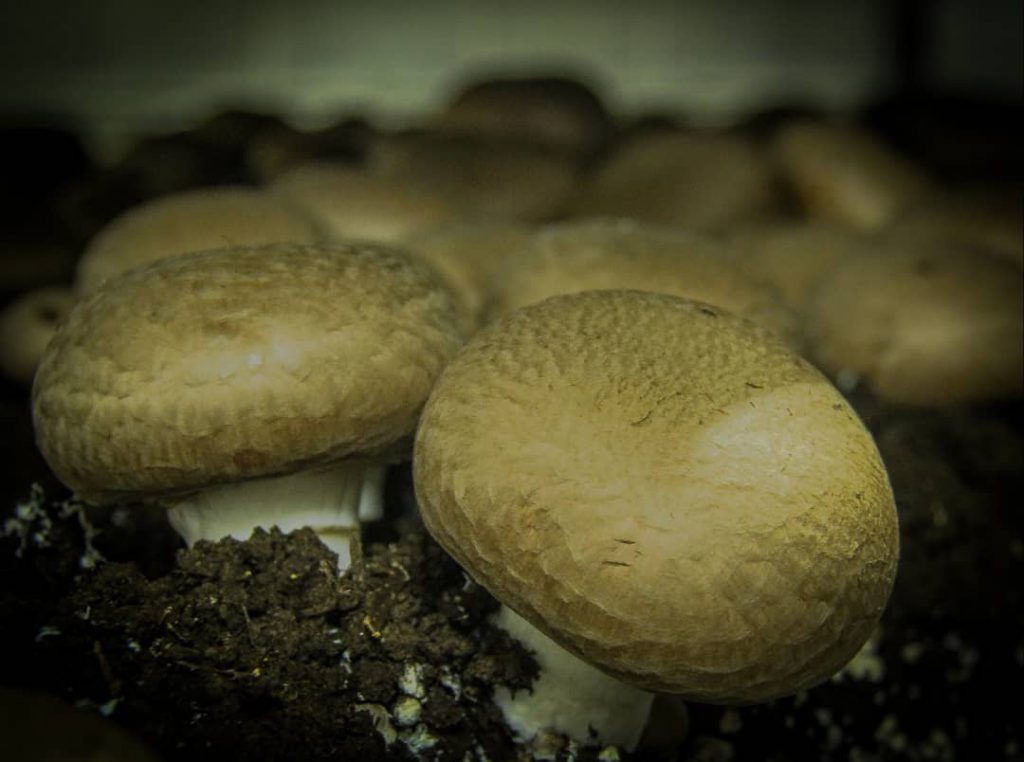
Similar species
Representatives of the mushroom genus are generally all quite similar to each other.
Most similar to the double-peeled champignon:
Champignon Esseta
It grows in the wild, usually in a coniferous forest. It differs in appearance in that the leg has a rather thin, on which the fragmented ring of a private bedspread is located. This species is edible and tastes good.
Curve champignon
It grows in the same conditions as the Asset champignon. It is edible, but in appearance it is extremely similar to the white toadstool (it differs from it in the pronounced aroma of anise).

Not as tasty as the representatives described above, belongs to the conditionally edible category. This champignon has a pinkish-white color and a fine velum residue on the stem.
Champignon yellow-skinned (poisonous)
It looks like an ordinary wild-growing champignon, its difference is that a yellow spot is formed upon mechanical action on the cap. In addition, the ring on the leg is two-layer.


Möller's champignon (variegated)
Has a gray-white cap with darker gray or brown scaly growths. The stem of this mushroom is white (at a young age), then becomes yellow to brownish.
Grows in a park area on alkaline soils. The mushroom belongs to the category of poisonous.
Edibility
Champignon double-pore belongs to the 2nd category of edible mushrooms in terms of nutritional value. It can be used in any type and dish.
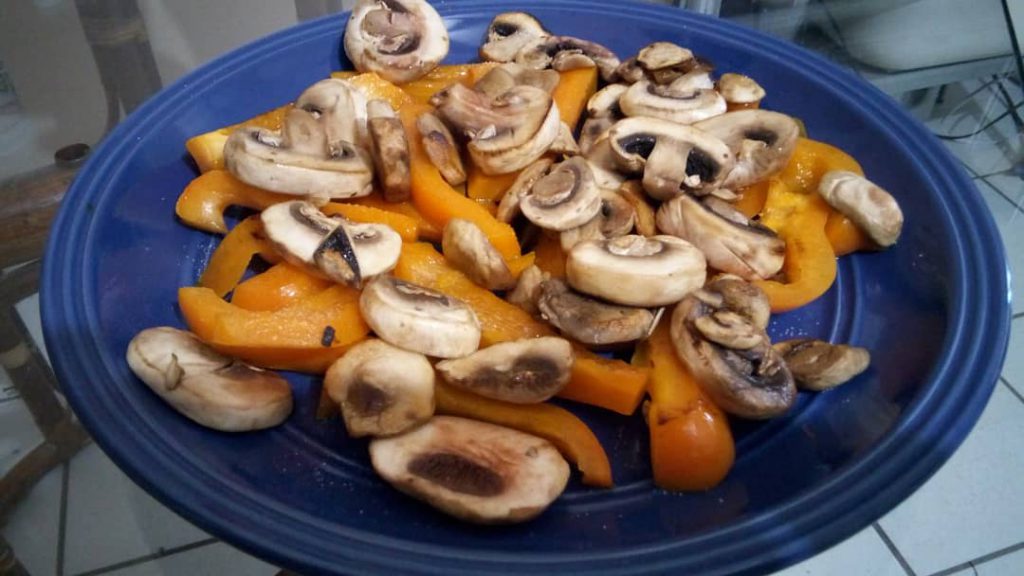
Interesting Facts
The history of mushroom cultivation dates back to the 17th century (at least, the first mentions of this date back to this century). For the first time, the Italians and the French began to specially grow champignons (in the beds and in abandoned quarries). By the middle of the 18th century, Russia also became interested in mushroom cultivation.
At first, it was believed that the cultivated champignon is the closest relative of the wild-growing Common champignon, but later the double-peeled champignon was described as a separate species. They tried to grow other species as well, but it is the double-pore champignon that grows best on manure.

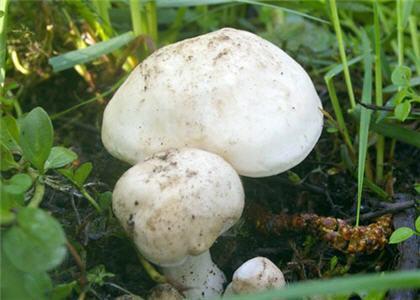

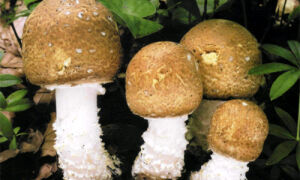
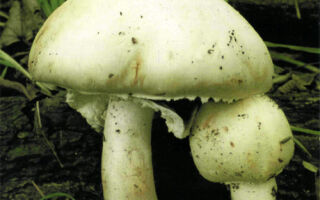
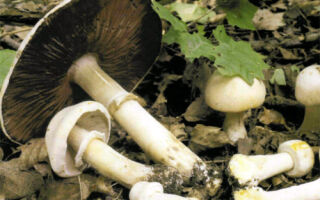
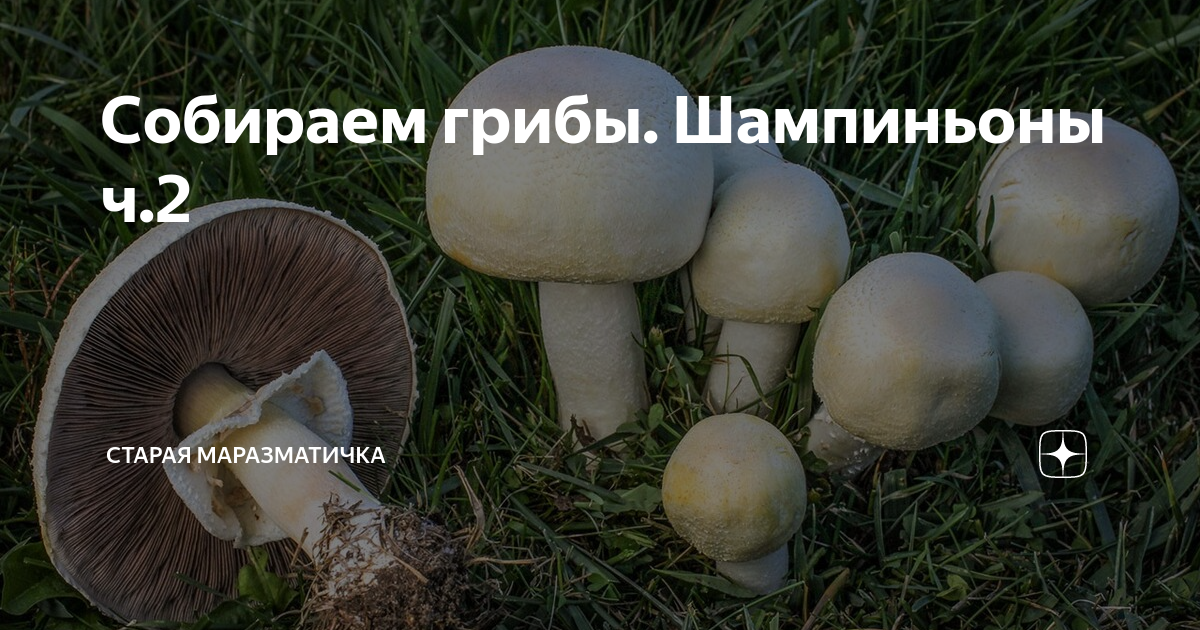






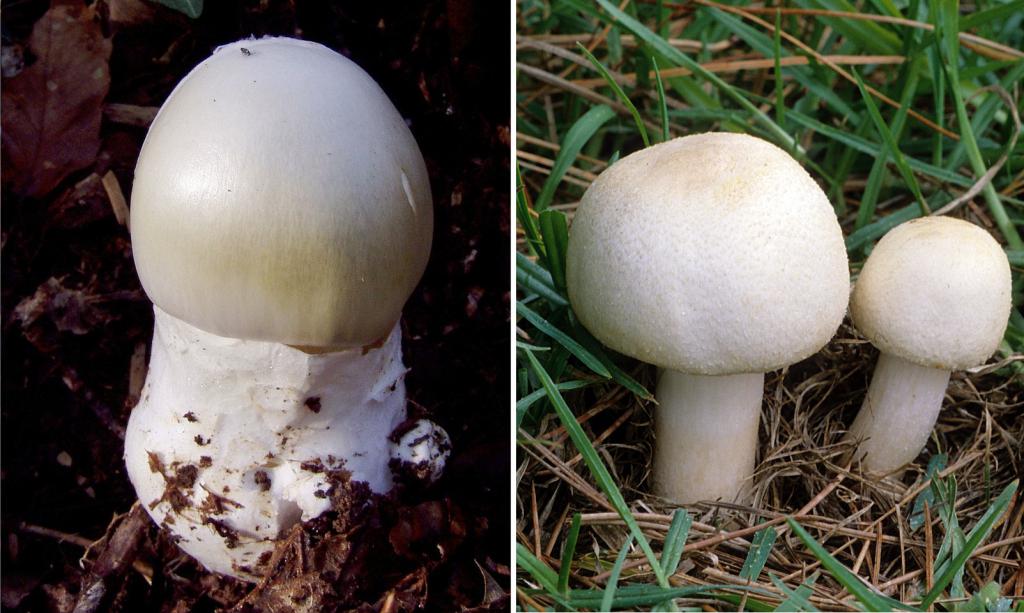




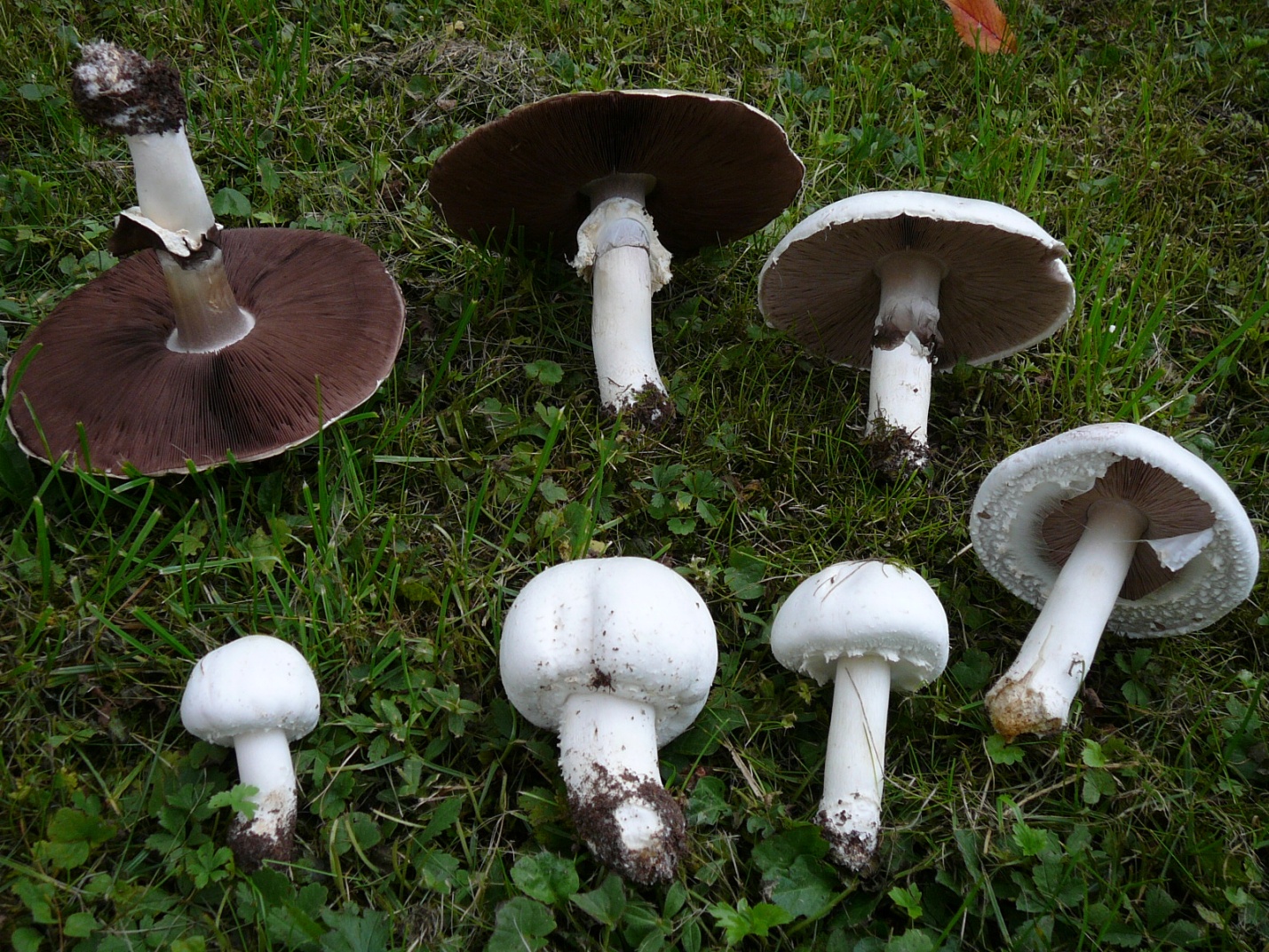

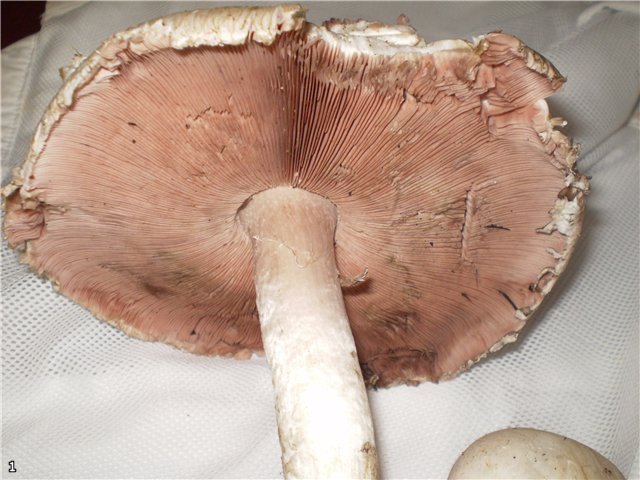


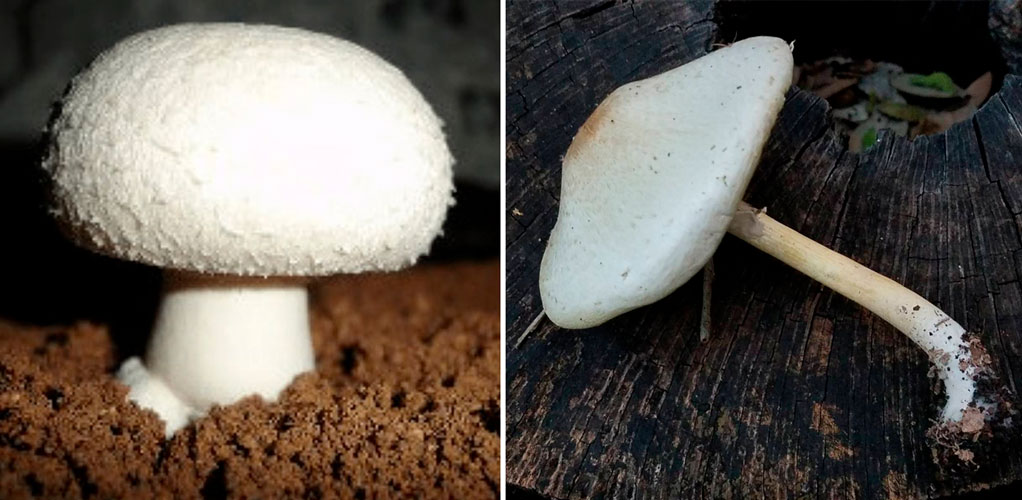




 Yellow-skinned champignon
Yellow-skinned champignon










